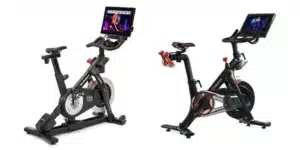I’ve been riding an indoor bike for more than three years, fairly relentlessly.
I rarely miss a day.
When the pandemic hit, I stopped going to the gym and never returned. I turned to cycling, dragging my bike from the garage and hitting the road, and I never looked back. I rode every day during the height of the pandemic and almost immediately fell back in love with something I had adored as a child.
I spent months exploring streets and paths and everything in between.
Eventually, as summer turned to autumn and I could see winter looming in the distance, I realized I needed an indoor bike to continue riding when the weather turned bad.
Given it was the pandemic and supply chains were stretched, my choices were limited. I essentially had two:
A NordicTrack or a Peloton.
Given the number of people who own and love them, I assumed a Peloton was the correct choice, but I decided to research anyway and complete my due diligence.
What I discovered was this:
The NordicTrack is a far superior indoor bike for several reasons, including:
In addition to classes similar to Peloton, NordicTrack offers an endless number of rides worldwide. Instructors take you out of the studio and to every part of the globe—mountains, forests, cities, deserts—on a large screen with excellent resolution and sound. I never feel like I’m riding in the Alps, but I kind of almost feel like I’m riding in the Alps sometimes.
Also, unlike the Peloton, the NordicTrack rises and declines to match the terrain. This synchronicity of resistance and incline provides a more authentic experience.
The NoricTrak also has a fan that will blow on you throughout your ride, which sounds marginal but is enormously beneficial.
The NordicTrack is more comfortable.
The one apparent advantage that Peleton has over NordicTrack is the quality of the classes. Some Peloton instructors have achieved celebrity status, and the music played during these classes is apparently superior to that of the NordicTrack.
Maybe this matters to some, but given the NordicTrack’s other advantages, I decided that B+ instructors, with all the added features, outweighed the A+ instructors that Peloton reportedly has. Also, I can’t stand those classes. I’d much rather ride in the deserts of Arizona, the mountains of Chile, or the streets of San Fransisco as an instructor encourages me along.
Also, everything feels more realistic and engaging on a NordicTrack.
As you climb Lombard Street in San Francisco, the bike elevates and increases resistance, making you feel like you’re riding uphill.
When you reach the summit of a mountain in Switzerland and begin your descent, the fan’s speed increases, blowing wind in your face as the bike leans forward and resistance decreases.
NordicTrack also uses Google Maps to allow riders to ride anywhere in the world. There is no coach on these rides, but if you want to ride through the neighborhoods of your childhood, you can use Google Maps and Street View and ride along streets that you last rode on as a child. And the bike will even rise and decline to match the terrain.
I love this bike.
Still, I wondered if the Peloton had some indiscernible quality I did not understand. Since I had never tested a Peloton, I always worried that I had made a mistake when purchasing my bike.
What was I missing?
What did Peloton riders know that I did not?
But when I travel, as I often do, I ride bikes in hotel fitness centers, and those bikes are almost always Pelotons, so I’ve spent my fair share of time riding them now – including for three days recently – and here is what I know:
They suck.
They are stationary bricks. Unformfotable chunks of iron. Static pieces of metal that only offer persistently happy, exceedingly fit instructors who shout at you from darkened studios, telling you what to do with smiles and enthusiasm that make me want to throw toasters at them.
They really do suck.
It’s also the perfect example of storytelling at its best. Peloton has managed to tell a story of luxury and quality that consumers believe by positioning itself as a premium brand used by celebrities like Kim Kardashian, Hugh Jackman, and Ashton Kutcher and building a community around celebrity trainers who leverage social media to connect to their riders.
When choosing a bike, there was only one luxury brand: Peloton.
Post-pandemic, you now have many choices when choosing an indoor bike. Supply chains remain strained in specific product categories, but not exercise equipment, so perhaps there are bikes on the market that are even better than Peloton and NordikTrack.
Also, Peloton is now in deep financial trouble. Its stock has gone from a high of $162 per share in 2020 to less than $3 today. The company is desperately trying to shed its luxury brand image and win over the everyday person as it loses hundreds of millions of dollars every quarter.
It’s uncertain if they will succeed.
iFit Health & Fitness – the company that owns NordicTrack – is not a publicly traded company, so it’s impossible to know how they are doing financially.
But in terms of Peloton and NordicTrack’s indoor bikes, one is far superior to the other.
I’m happy I made the right choice almost four years ago.









